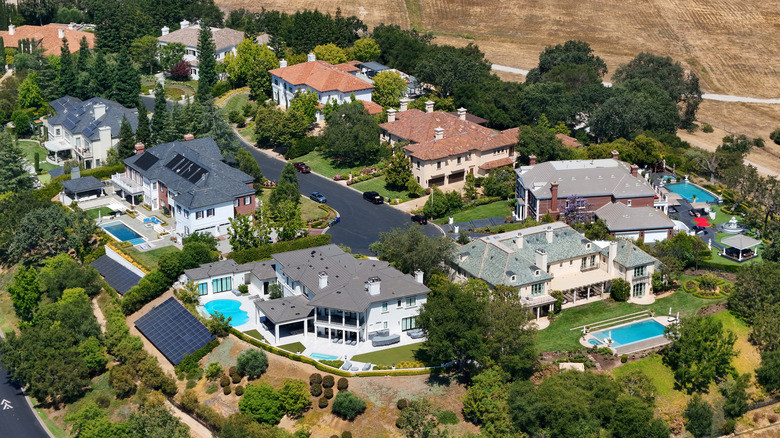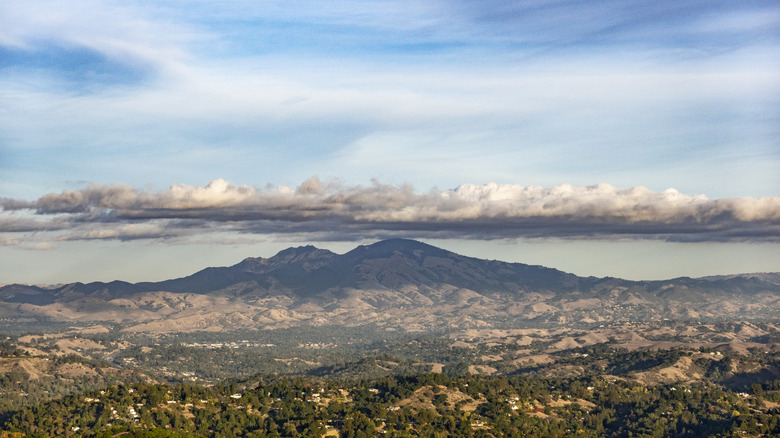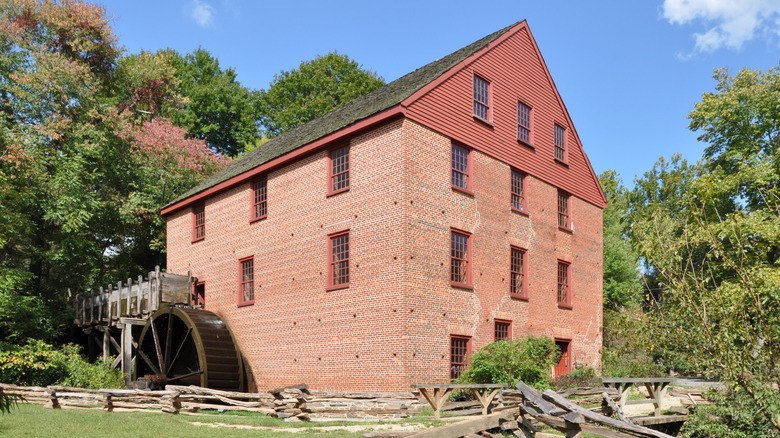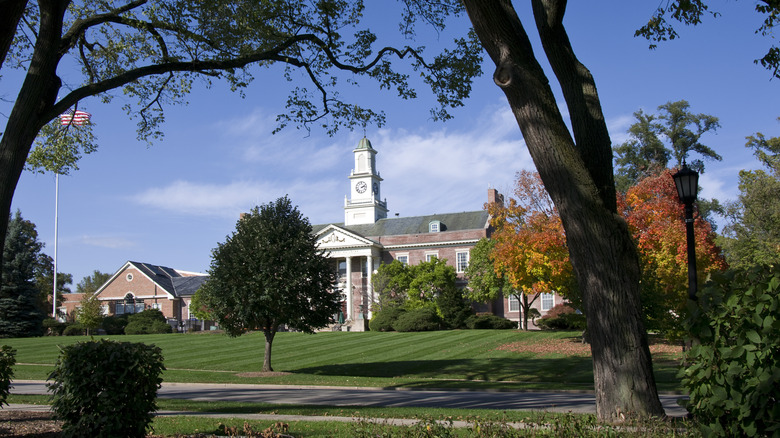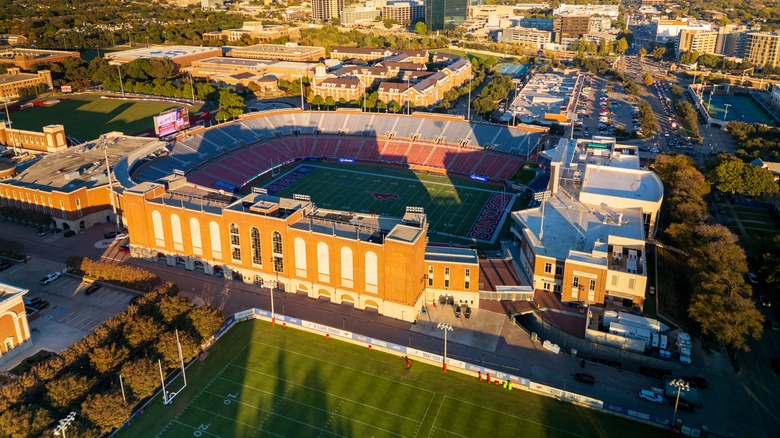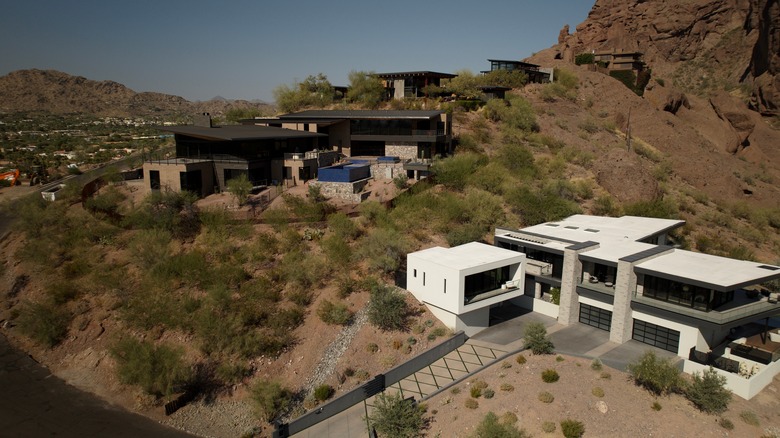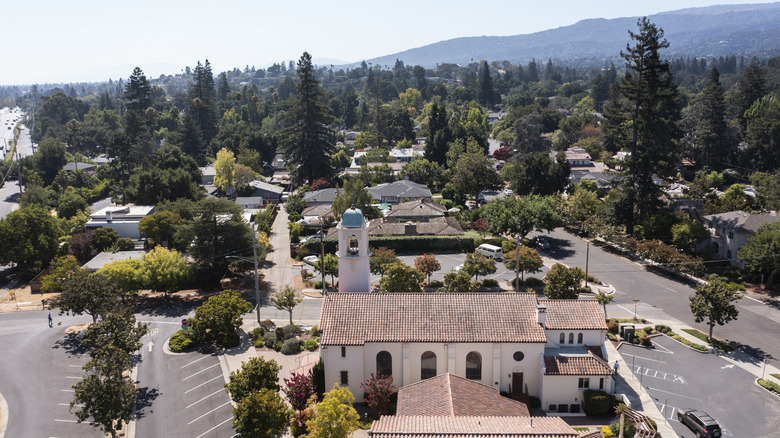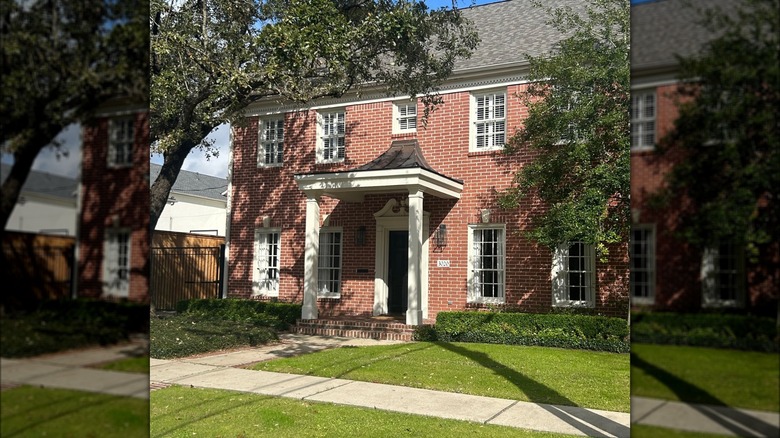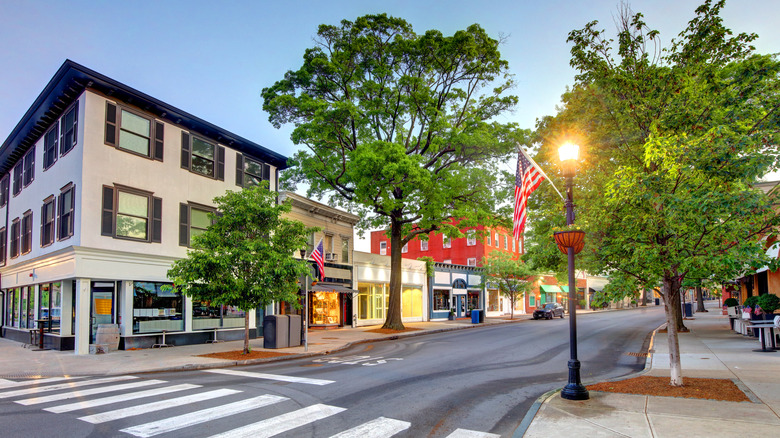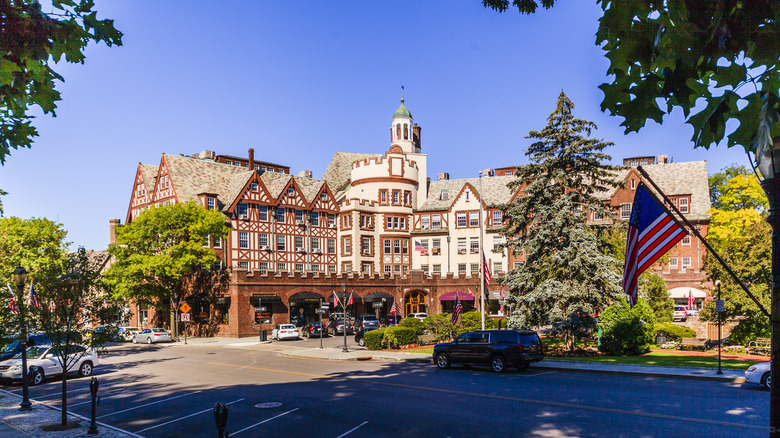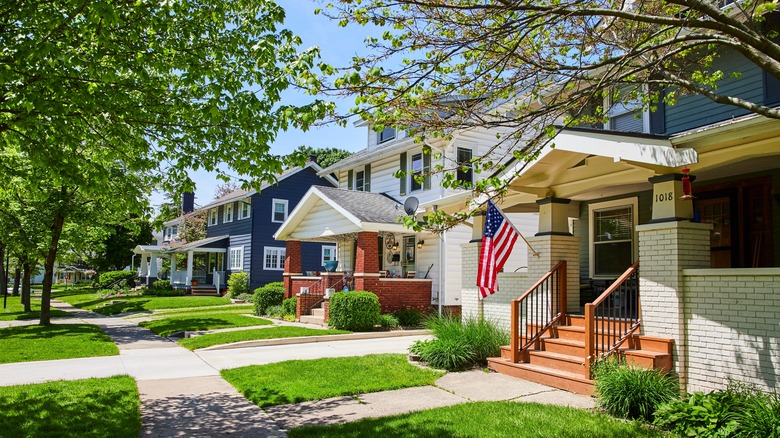These Are America's Wealthiest Suburbs In 2025, According To Research
In the years following World War II, veterans and their families flocked to the American suburbs. They put down roots in colorful, cookie-cutter communities thanks to GI benefits, and commuted to work in their Chevrolets, Chryslers, and Cadillacs on freshly-paved highways. In the decades since, the country's suburbs have only continued to grow, and while some are still home to those mass-produced ranch-style houses popular in the '50s, some look a little different. You'll find dozens of upscale communities on the outskirts of cities like San Francisco and Sunnyvale, for example, all thanks to the growing influence of the tech industry. Single-car garages have been replaced by double- and even triple-car contraptions, and, in general, homes are bigger. A lot bigger.
Our search to find America's wealthiest suburbs, determined using average household income as well as home value, began with Go Banking Rates. Some towns are old-money vestiges, rich in history and shaded by century-old trees, and others are brand-new, built to accommodate the wealthy outside up-and-coming cities. That being said, we found that these communities typically have a few common denominators: Chic downtowns with upscale (and sometimes even Michelin-recognized) restaurants, lush parks, golf courses, natural beauty, and top-rated public schools. Listed below, in descending order from least-wealthy to wealthiest, are the most affluent suburbs in the United States of America.
10. Wellesley, Massachusetts
Nestled in the hills of western Massachusetts, approximately 15 miles from downtown Boston, is Wellesley. According to Iram Farooq, who works as an assistant city manager in Cambridge (per Bloomberg), suburban communities are "primarily residential" with low densities and single-family homes. That description certainly fits Wellesley, where you'll find approximately 30,000 residents and plenty of brick homes dating back to the late 19th and early 20th centuries. At the time of writing, the community's average home value hovered around $2 million, according to tech real-estate marketplace Zillow. In 2024, there was even a five-bedroom home in Wellesley listed for $17.5 million. Mature trees line the streets, and some are (likely) even older than the homes they shade. Every winter, when New England's days are short and cold, the Massachusetts Horticultural Society hosts a lighted "Festival of Trees" in the Garden at Elm Bank.
In Wellesley, the average household income is $367,801, significantly higher than the national average. It's common for residents to commute into work in Boston (train leaves every two hours from Wellesely Hills station), and some locals work closer to home at Wellesley College, which just so happens to be the alma mater of former presidential candidate Hillary Clinton, writer Nora Ephron, former Secretary of State Madeleine Albright, and many, many more. For decades, the rich, famous, and well-connected have explored the suburb's quaint downtown, stopping in for pasta dishes at restaurants like Alta Strada, trying samples at local cheese shops, and, during the holiday season, shopping for gifts at boutiques along Central Street. It's all very picturesque, like a village one might spot on a long-ago postcard.
9. Orinda, California
Since the era of the Gold Rush, sunny California has attracted wealth-seekers from around the country. Today, newcomers are on the hunt for tech jobs in Silicon Valley as opposed to precious metals. Home to just under 20,000 people, Orinda is located about 9 miles from Oakland and 17 miles from San Francisco, both cities are accessible via the yellow BART train, and yes, it's common for locals to work at major tech corporations like Apple, Capital One, Adobe, and more. Salaries are high, and self-driving cars are more than just a pipedream: They're real, and they honk.
The average household income in Orinda is about $370,000, and homes are typically valued at a little over $2 million. You'll find varied architectural styles: sprawling mid-century ranches shaded by palms, walls made entirely of windows near the Orinda Country Club, and luxury estates with their own pools and tennis courts. The suburb's small downtown is walkable, and you'll be able to hop between vibrant sushi counters, ice cream shops, taco joints, and the old-fashioned Orinda Theatre, which shows arthouse films, hosts comedy festivals, and brings in touring musicians.
The suburb's public school district is top-rated, according to Niche, and you'll also find plenty of hiking trails(some of which have skyline views) in the area. All in all, it's the ideal community for Silicon Valley-ians who want peace and quiet at night — and maybe even a trip to an old-fashioned cinema — after long days of writing code.
8. Great Falls, Virginia
Coveted for its proximity to Washington, D.C. (just 20 miles away), luxurious private country clubs, and top-tier Fairfax County public schools, Great Falls in Virginia is consistently ranked among the country's most expensive suburbs. Homes typically range between $1 million and $7 million, and it's common for folks to have large lots with amenities like in-ground pools and more. Understandably, to afford the expensive real estate, the average household income amongst residents is substantial, coming in at around $374,000. It's common for people in Great Falls to work in industries like public administration and healthcare.
Beyond its glamorous homes, perhaps the most notable thing about this D.C. suburb is its natural beauty. At Great Falls Park, an underrated destination just outside the nation's capital, fall is peak season. The Potomac River flows into cascading waterfalls, and there are plenty of hikes, equestrian trails, and fishing opportunities to enjoy beside the canal. Plus, D.C's proximity means it's easy to travel across the country — or even the world — using Dulles International Airport, just 12 miles away.
7. Hinsdale, Illinois
About 20 miles from the Windy City is Hinsdale, a charming Illinois village with a picturesque downtown, good eats, and a friendly community. It's also known as one of Chicago's most expensive suburbs; the average household income here is more than $380,000, and it's typical for homes to cost well-over $1 million. At the highest end of the spectrum, you'll find French-inspired architecture from the 1920s, where pitched roofs and elegant chimneys poke above shrubbery. Streets are wide, sidewalk-lined, and shaded by trees. Some residents live near the local golf club, which was founded in the late 19th century, and more than a dozen buildings in Hinsdale belong to the National Register of Historic Places. It's a relic from another time enjoyed by today's wealthiest.
Downtown, you'll find art galleries, upscale cosmetic stores, a small history museum, and a vibrant food scene, all housed behind century-old brick facades. Residents have their pick between gluten-free bakeries, sushi, and steakhouses. A train track cuts through town, offering direct passage to Chicago and the misty banks of Lake Michigan, where it's common for residents to work.
6. University Park, Texas
Home to a little over 25,000 people, just north of Dallas, is a suburban Texas community called University Park that is sometimes referred to as "The Beverly Hills of Texas," per Mansion Global, thanks to its rather impressive single-family homes. You'll find million-dollar manors with towering ceilings, grand staircases, and multi-car garages. As Texas doesn't have a state income tax, it often attracts the country's highest-paid workers, so it's typical for University Park residents to make around $381,000 annually and to seek employment in the oil industry, education, and healthcare.
As its name suggests, University Park is also home to a college: Southern Methodist University. The school has produced the likes of Academy Award winner Kathy Bates, former First Lady Laura Bush, and plenty. Even locals who aren't affiliated with the school can take advantage of collegiate-level athletic events, stage productions, and concerts. It is an integral part of the community, to say the least.
As is the case with most of the country's elite suburbs, the public education in University Park is also highly esteemed. "The schools are good not only because of the teachers and the academics, but they're good because of the involvement of parents," Taylor Armstrong, Texas architect, tells Mansion Global. "You can go by any of our parks on a [nice] day and it looks like a Norman Rockwell painting, with the kids out there playing and the parents coaching and on the sidelines."
5. Paradise Valley, Arizona
Paradise Valley is a suitable moniker for this desert suburb, a town of luxury resorts, cactus-lined trails, golf courses, and spa escapes. It's all located about 15 miles from Phoenix and less than 4 miles from Scottsdale, larger cities where it's common for residents to find work. The area is coveted due to its one-of-a-kind natural beauty, from canyons to mountains. Dozens of resort hotels (including the JW Marriott Camelback Inn Resort and Spa and the Camelback Inn) dot the landscape, and local hikes wind between massive saguaro cacti. Keep in mind, however, that some of the local trails are listed amongst the most dangerous hikes in Arizona, due to extreme temperatures in the summertime.
The average household income in Paradise Valley is $385,643, which means that many residents can afford homes listed over $3 million. Windows offer sweeping sunset views behind Camelback Mountain, carefully landscaped grounds utilize desert plants, and luxurious pools offer an escape from the region's heat waves. Nearby, kids enjoy spending time in the McCormick-Stillman Railroad Park, which has a splash pad, a miniature train, live music, and light festivals throughout the year. If it all gets too hot, though, you can take advantage of Phoenix Sky Harbor International Airport (and its flights to over 100 nonstop destinations) just a short drive away.
4. Los Altos, California
At this point, California's Los Altos has pretty much solidified its status as one of the country's priciest suburbs. Like Orinda, it's largely due to its Silicon Valley location and the influence of the tech industry. San Jose and San Francisco are 25 and 50 minutes away, respectively, and it's common for residents to take on high-paying jobs at companies like Apple, Microsoft, or Amazon. Stanford University — another potential employer — is also nearby, which means athletic events, concerts, and public lectures throughout the academic year.
According to Go Banking Rates, the average annual income in Los Altos is $400,817. By comparison, the median household income in California is $95,521. The typical home value here is close to $4.5 million, and it's common to find Mediterranean-inspired architecture, lush outdoor pools, and even on-site Tesla chargers.
All in all, California's wealthiest suburb is a tree-lined haven packed with boutiques, cafés, and small-town charm. Locals don't have to travel far to find a wealth of restaurants, and quaint downtown streets are decorated with wreaths, bows, and lights every holiday season. On Thursday evenings between May and October, you can shop for local produce at the State Street farmers' market, or hike Black Mountain on the weekends.
3. West University Place, Texas
Given the Lone Star State's "no income tax" rule, it's no surprise that there's another Texas suburb on the list. West University Place is just 6 miles — or about 15 minutes — from Houston, and it's common for residents to work in fields like healthcare, law, and business management. The annual household income here is $403,845, per Go Banking Rates, and homes typically range between $1 and $5 million, averaging out at $1,605,049. You'll find brand new appliances, tall ceilings, and expertly manicured hedges. It's common for residents to live within walking distance of parks and playgrounds.
West University has ranked among the country's "Best Cities to Live," and its proximity to Rice University means a jam-packed calendar of lecture series and athletic events open to the public. For such a small town, West University is impressively rich in culture. Residents are also a short trip away from attractions like the Houston Zoo, home to more than 6,000 animals, NRG Stadium (where you can watch A-list touring bands, as well as pro football games), and the Museum of Fine Arts, where you'll spot works by famed painters Van Gogh and Monet.
2. Rye, New York
As expected, the most affluent suburbs in the country are linked to the wealthiest cities. Just outside of New York City — which, collectively, holds more wealth than any other city in America — is Westchester County. Here, you'll find Rye, which is home to approximately 16,400 people, A-plus-rated public schools, and a downtown with plenty of fine-dining options. Rye originally served as a summering destination for NYC's wealthiest, and has since turned into a coveted commuter town with its own distinctive charm. The average household income here is $405,074, and homes are typically listed over $1 million. The most expensive options are on the coast and in gated communities. Throughout the suburb, you'll find Tudor-inspired homes from the first half of the 20th century shaded by lush trees, geometric midcentury mansions, and sprawling estates.
Beyond its historic (and often luxurious) homes, the suburb is also coveted for its amenities. There are elite country clubs, hiking trails throughout Rye Nature Center, the local nature preserve, and sailors dock at the Manursing Island Club. Also on the coast, you'll find Playland, a 100-year-old theme park with wooden rollercoasters and concession stands selling classic carnival treats.
During the warmer months, downtown restaurants set up tables outside, and Purchase Street looks almost Mediterranean, loud with happy chatter and clinking glasses. Popular spots include Rafele for Italian, Oko for bento boxes and poke, and Longford's for their trademark blue-dyed "cookie monster" ice cream. A commuter train stops at the station downtown, offering passage to Grand Central Station in Manhattan.
1. Scarsdale, New York
When it comes to household income, Scarsdale in New York ranks high above the rest, making it number one on our list, the richest town on the East Coast. Here, the average family brings in $568,942 annually, enough to afford multi-million dollar homes, and expensive dinners out in New York City, which is just 30 miles or an hour away, depending on traffic. Scarsdale residents have included famous politicians, Nobel Prize winners, and respected authors, and the area's been featured prominently in pop culture (including the Marvel Cinematic Universe). Kids can enroll in the Scarsdale Union Free School District, which is the highest-ranked in Westchester County, but it's also common for parents to send their kids off to nationally-recognized private schools, where tuition is equivalent to a college education.
The suburb is dotted with parks, playgrounds, and elite country clubs. Downtown Scarsdale looks like an old-fashioned English Tudor village, complete with dramatically pitched rooftops and town squares. Stores sell gold and diamond-encrusted watches, high-quality men's suits, and home decor, and single plates at some restaurants — like Bistro de Ville — can cost you close to $100. Even grocery stores here are a cut above the rest, stocked with specialty cheeses and wines. Trains stop downtown, beside Bronx River waterfalls, on their way toward glistening Manhattan skyscrapers.
Methodology
Although home values were certainly a consideration in our list, our ranking system was primarily based on average household income, per Go Banking Rates. We used additional resources like Zillow, U.S. Census data, and city websites to confirm. Ultimately, America's suburbs are still expanding, but now that we're well into the 21st century, there's less and less room to grow ... No more cookie-cutter ramblers ordered from a catalogue, no more Levittowns. That means suburbs have also gotten more expensive. In Wellesley, Massachusetts, for instance, home prices increased by close to 9% between 2024 and 2025. The same goes for Paradise Valley, Arizona, where prices went up by more than 10%.
However, it's not just America's wealthiest suburbs that are growing and changing. In recent years, suburbs across the United States have relied on nonprofits like Main Street America to revive their downtowns. Across the country, you'll find colorful murals, restored movie theater marquees (like the one in Orinda, California), mom-and-pop shops, and vibrant festivals along once-quiet Main Streets. In other words, you don't have to make $500,000 a year to enjoy the peace and quiet of small-town America and easy access to a larger city. In every state, there are towns with distinctive personalities, unique histories, and jobs just a commute away.
